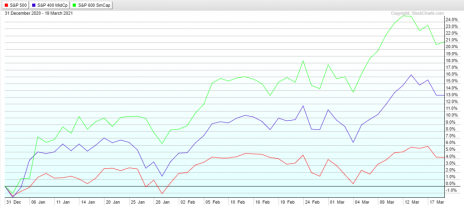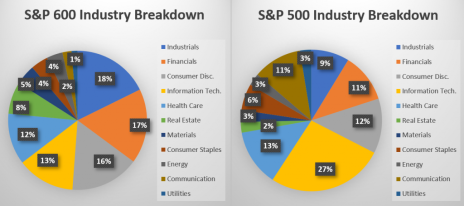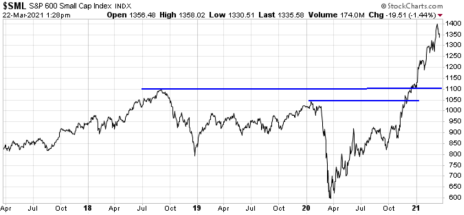Small-cap stocks have been on a tear in early 2021. Can they keep it up? Here are a few reasons why the answer is yes.
You may have noticed the significant outperformance of small-cap stocks lately.
Through Friday, March 19, the year-to-date gain in the S&P 600 Small Cap Index was 21%. That performance is well ahead of the 13% rise in the S&P 400 Mid Cap Index, and absolutely demolishes the 4% rise in the S&P 500 Index.
The index’s high of 1,400, struck last week, marks a 27% jump over the previous high water mark of 1,100 from August 2018. The small-cap index didn’t even blink as it blasted through resistance at 1,046 from January 2020.
The big questions now are these: Why such a big move in small-cap stocks? Is the advance justified? Can it continue? How do I play the strength?
Let’s handle these questions in order.
[text_ad]
Why Such a Big Move in Small-Cap Stocks?
The main reasons for the advance is that the small-cap asset class was extremely depressed during the pandemic, and even before that had underperformed large-cap stocks for some time. That’s because of relative underweight exposure to the high-growth sectors that had powered the S&P 500, namely technology, which carries a 27% weight. In contrast, the S&P 600 small-cap index is only 13% exposed to tech.
There was a lot of room for some relative outperformance to close that gap, but small caps needed financials, industrials and consumer discretionary to kick into gear, and for a pause in large-cap tech. That began to happen this year.
Additionally, small caps tend to do especially well during mid-cycle recoveries because of high exposure to cyclical stocks, higher capex spending and the U.S. economy. That reality has not been lost on big investors, who see small-cap stocks as a “no-brainer” way to invest in a re-opening of the U.S. economy this year and possibly booming economy heading into 2022.
This recent note from Bank of America Global Research on March 15 sums it up: “During prior Mid-Cycle phases (excluding the Tech Bubble), our work suggests that small caps have outperformed large caps. … Small caps’ sales growth has been highly correlated with U.S. capex cycles (88% correlation between y/y sales growth and U.S. quarterly y/y capex growth since 1985), more so than large caps’ (76% correlation).”
Is this Advance Justified?
Yes. Small caps represent a levered bet on the U.S. economy due to high domestic exposure. Historical data suggests that when GDP is growing above 2% small caps do very well. There is also evidence that small caps do well in inflationary periods. The Fed’s efforts to get inflation up to around the 2% target (and even more, for a little while), and investor belief that inflation is actually going to run hotter than the Fed expects, supports small-cap performance. Finally, the uptrend in interest rates has buoyed the outlook for financial stocks, which comprise a big part of the small-cap index.
Can the Small-Cap Stock Run Continue?
Yes, but perhaps not at the same pace as we’ve seen so far in 2021.
Small caps continue to trade at a roughly 10% discount to large caps, yet historically the asset class tends to trade at a 3% premium. Even after such a furious rally, data from Bank of America suggests active funds are underweight small caps and still overweight large caps, despite small-cap exposure to a U.S. economic recovery, a re-opening of the economy and historical mid-cycle outperformance during periods of rising inflation.
Historical data also suggests that small caps should fare well as we move toward a likely period of rising interest rates. Check out the table below. As you can see, stocks generally do well during periods of rising rates, and small caps (along with the Nasdaq) tend to do better than the broad market.
How Do I Play the Strength?
The evidence is compelling for continued small-cap performance in 2021 and 2022. Even if the advance isn’t as rapid as it’s been so far this year it makes sense for investors to have some exposure.
By far, the easiest way to do that is with an ETF. I prefer the iShares Core S&P 600 Index ETF (IJR) because it tracks a higher-quality index than the iShares Russell Russell 2000 ETF (IWM). But either one will give you the exposure you’re looking for.
If you want to turn up the dial a little, you can go with a levered ETF, such as those offered by Direxion and ProShares. Be sure to read up on these levered options if you buy as there are risks, and they may not make a lot of sense as buy-and-hold investments.
Another option is to buy small-cap sector ETFs to get the precise sector exposure you want. These are offered by Invesco.
The final option is to invest in individual small-cap stocks. This strategy gives you the ability to build a portfolio of stocks for the precise exposure you want, whether that be technology, health care, industrials, energy, whatever.
If this is the route you go, consider owning the stocks I cover in Cabot Small-Cap Confidential. You’ll receive institutional quality research reports on each name, as well as weekly coverage on all portfolio stocks and Special Bulletins when there’s breaking news. We’re always tweaking our exposure to suit the times. We have an average gain of 208% on current positions.
If you’re interested in joining our small group of subscribers, I’d love to have you. Get started here.
[author_ad]





